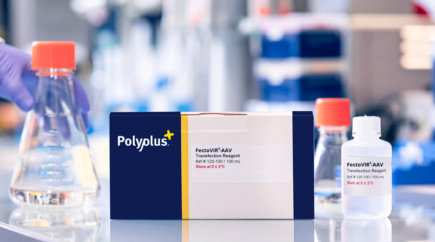Available at research and GMP grade to intensify production of recombinant AAV rAAV viral vectors at any scale from benchtop to 2000L scale bioreactor...

We use cookies to help you navigate efficiently and perform certain functions. You will find detailed information about all cookies under each consent category below.
The cookies that are categorized as "Necessary" are stored on your browser as they are essential for enabling the basic functionalities of the site. ...
Necessary cookies are required to enable the basic features of this site, such as providing secure log-in or adjusting your consent preferences. These cookies do not store any personally identifiable data.
Functional cookies help perform certain functionalities like sharing the content of the website on social media platforms, collecting feedback, and other third-party features.
Analytical cookies are used to understand how visitors interact with the website. These cookies help provide information on metrics such as the number of visitors, bounce rate, traffic source, etc.
Advertisement cookies are used to provide visitors with customized advertisements based on the pages you visited previously and to analyze the effectiveness of the ad campaigns.
Meet our Team at the booth #320 and listen to our talk during Cell & Gene Therapy Manufacturing & Commercialization US!
With the rapid growth of the gene therapy market, many manufacturing challenges still need to be addressed in order to efficiently produce large volumes of recombinant AAVs. Transient transfection of suspension cells is the most commonly used production platform for AAV manufacturing. Twenty years of transfection expertise has led Polyplus to the development of the next generation transfection reagent, FectoVIR®-AAV. In our presentation, we will discuss how FectoVIR®-AAV addresses the current AAV manufacturing limitations with i) increased AAV titers, ii) improved industrial transfection protocols, and iii) high quality and GMP compliance.
Presented by Ashlee Sun, PhD, Field Application Specialist at Polyplus-transfection.
Wednesday, 22 September 2021 2:30pm – 3:00pm EST/EDT
Ashlee Sun, Mathieu Porte, Mégane Denu, Marine Ricordel, Jonathan Havard, Yann Philipson, Malik Hellal, Patrick Erbacher
The number of ATMP therapeutic-based medicines for inherited genetic disorders is in constant growth, with a global 32% increasein new clinical trials in the last 4 years. ATMPs have demonstrated their success with already more than ten approved for commercialization. The success of AAV as the most promising viral vector for gene therapy is due to low immunogenicity, broad tropism and non-integrating properties. One major challenge for translation of promising research to clinical development is the manufacture of sufficient quantities of AAV. Transient transfection of suspension cells is the most commonly usedproduction platform, as it offers significant flexibility for cell and gene therapy development. However, this method presents some limitations in largescale bioreactors: inadequate transfection protocol, reduced transfection efficiency and lower productivity. To address this concern, we present data on a novel transfection reagent showing: i) increased AAV titers, ii) improved transfection protocol for large scale bioreactors and iii) reproducibility of viral titers at different production scale. The aforementioned optimizedparameters make this novel transfection reagent ideal for cell and gene therapy developers by combining the flexibility of transient transfection with scalability and speed to market.